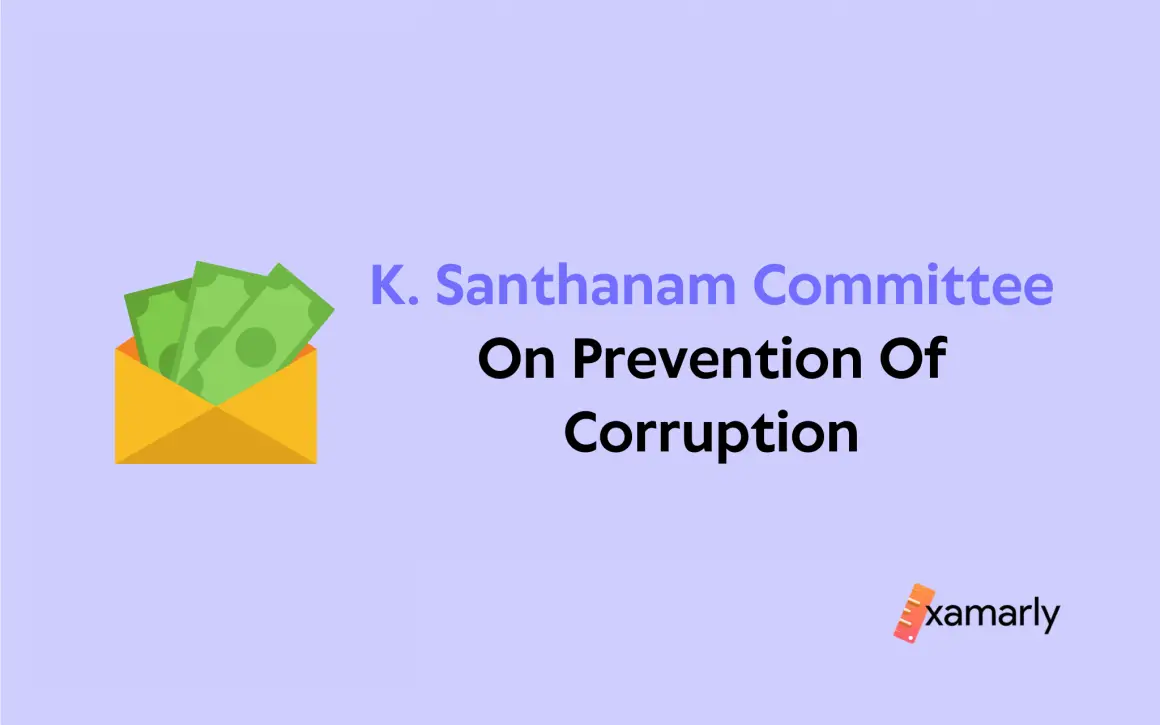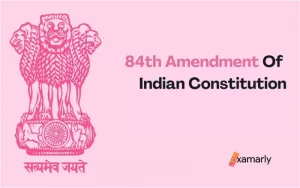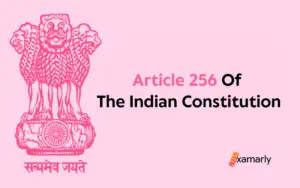In 1962, Lal Bahadur Shastri established the K Santhanam Committee on Prevention of Corruption. K. Santhanam, a highly respected investigator with an impeccable reputation, headed the committee.
He advised the Central Government about the detection of maladministration and it’s prevention. From the investigations, he helped bring about an ocean of changes in the Indian political landscape.
- Objective of K Santhanam Committee on Prevention of Corruption
- Who was K Santhanam?
- Key Recommendations of the K Santhanam Committee on Prevention of Corruption
- The Prevention of Corruption Act
- Significance of K Santhanam Committee on Prevention of Corruption
- When and why was the K Santhanam Committee formed?
- Conclusion
- FAQs on K Santhanam Committee on Prevention of Corruption
Objective of K Santhanam Committee on Prevention of Corruption
The K Santhanam Committee was an anti-corruption committee and was established by the Government of India in 1962 to study corruption-related offences in the public sector and government departments in the Central government, union territories, nationalized banks, and PSU officers.
It was formed to make reforms and suggest anti-corruption measures in the government, its departments, and the Public Sector. The government was required to undertake the below-mentioned preventive measures to fight the menace of corruption and make it an offence:
- Establishing anti-corruption laws.
- 1-year monitoring of files related to procurement, construction, maintenance of public buildings, etc.
- Loan and financial assistance related file monitoring to ensure zero private gains.
- Limitation of private profits obtained by public workers in the form of loans, other financial help from financial companies, and so on.
- The committee referred to the study of other concerns not covered by the preceding.
Also Read about the Financial Emergency: Article 360 of Indian Constitution.
Who was K Santhanam?
K Santhanam was a former Chief Justice of the Punjab and Haryana High Court in India. He was appointed as the chairman of the committee set up by the Indian government in 1962 to suggest measures for the prevention of corruptive practices in public life. He is also known for his work in the fields of law and justice.
He was born on 23 November 1898 and passed away on 6 September 1980. He had a long and distinguished career as a judge and jurist in India.
Read about India’s premier public service: IAS Full Form: A Comprehensive Outlook.
Key Recommendations of the K Santhanam Committee on Prevention of Corruption
The report included a series of recommendations for combating corruption practices.
- It recommended the creation of a Central Vigilance Commission, the apex vigilance institution, to look into cases committed against central government officials. It is an autonomous body.
- It also suggested the establishment of special courts to investigate and appoint special judges.
- It recommended that rules be established for filing assets and liability declarations, dealing in stocks, raising contributions, and other matters.
- The Committee recommended the creation of the Central Bureau of Investigation as the Union Government’s primary investigative agency. This independent body has the authority to investigate and punish. It acted as an advisor to government officials on integrity issues in public administration.
- Its recommendations include educating citizens concerning their rights, and responsibilities, as well as ensuring that the government works for the same.
- Employees of all departments should get access to regular recreational activities.
- Employees should be entitled to avail housing, medical facility, etc. Periodic review and appraisal of salaries to be done.
- The provision of offering bribes should become a substantive offence. Government servants should be only appointed to posts if the eligibility criteria are met. They should not immediately take up private commercial employment, immediately, after retirement.
- Companies and businesses must keep detailed records of all accounts of expenditure. Administrative delays should be cut, as they can be a big source of this crime.
- Periodic reviews of taxation laws, granted licenses, and permits.
Read more about the Finance Commission: Article 280 of Indian Constitution.
The Prevention of Corruption Act
To combat corruptive practices in Indian government offices and public sector firms, the Indian Parliament passed the Prevention of Corruption Act in 1988.
For the first time this act was made to tackle this situation. This act required special judges to be appointed by the Central and State governments. A Session Judge/Additional Session Judge/Assistant Session Judge can only be appointed to the post of Special Judge.
This act has made bribery a crime under the Criminal Code. To ensure that bribes are dealt with effectively and promptly, it was amended. Its five chapters and 31 sections detail the rules and penalties that apply to public servants.
You might also like to read: Administrative Relations Between Centre and State.
Significance of K Santhanam Committee on Prevention of Corruption
The K Santhanam Committee was a crucial committee for India. It was created to investigate corrupt behavior, but the report it produced was crucial for reading both inside and outside the Indian subcontinent.
The recommendations provided by the Santhanam Committee were noteworthy because they:-
- served as the cornerstone for a new set of legislation addressing corruptive practices in India.
- resulted in the appointment of Lal Bahadur Shastri as Prime Minister.
- resulted in the appointment of Kamla Nehru as External Affairs Minister.
- resulted in the establishment of special courts to deal with cases and the establishment of a Bureau to investigate various concerns alluded to by the K Santhanam Committee.
- made possible the creation of a Central Vigilance Commission.
Many of the recommendations made by the Santhanam Committee were implemented by the government.
Read Also: Advisory Jurisdiction of Supreme Court.
When and why was the K Santhanam Committee formed?
Established in 1962 to combat corruption in the Indian government, it was recommended by Lal Bahadur Shastri. The Committee was given the responsibility to recommend reforms for investigating corruption cases and recommending reforms to India’s criminal justice system.
The Santhanam Committee Report is a landmark document within the Indian anti-corruption movement. The recommendations of this Committee led to the establishment of a non-statutory body, the Central Vigilance Commission by the Government in 1964.
Central Vigilance Commission is an autonomous and advisory body. It is responsible for all activities related to the central government’s field of vigilance. The commission advises the Government on major administrative challenges related to preventing corruption in Public Services and individual cases of corruption.
Read all about India’s premier recruitment agency: UPSC-Unraveling Everything About It.
Conclusion
The K Santhanam Committee was a committee formed by the Government of India in 1962 to examine the problem of corruption and make recommendations for its prevention.
The committee submitted its report in 1964, which included a number of recommendations for preventing corruption, such as strengthening laws and regulations, improving transparency and accountability, and promoting ethical behavior among public officials.
The report also emphasized the need for public awareness and participation in the fight against corruption. The recommendations of the committee were influential in shaping anti-corruption policies in India, and many of its suggestions have been implemented over the years.
You might also like to read: Anti Defection Law | 10th Schedule of Indian Constitution.
FAQs on K Santhanam Committee on Prevention of Corruption
Who headed the Committee on Prevention of Corruption?
Kasturiranga Santhanam, also known as K. Santhanam headed the Committee on Prevention of Corruption.
What was the role of the Santhanam Committee?
The K Santhanam Committee was formed to play a vital role in curbing corruption in the government and the public sector. It’s recommendations led to developing preventive measures for corruption.
When was the Central Vigilance Commission introduced & what was its role?
In the year 1964, the Indian government established the Central Vigilance Commission (CVC). An executive resolution served as the vehicle for its initial introduction. To advise and direct the Central Government in matters of surveillance is the responsibility of the Central Vigilance Committee.
What were key recommendations of the committee?
Some of the key recommendations of the committee included the establishment of a central vigilance commission, the creation of a code of conduct for public servants, the strengthening of anti-corruption laws, and the introduction of more transparency and accountability in government decision-making.
What was the impact of the committee’s recommendations?
The committee’s recommendations led to the establishment of the Central Vigilance Commission and the creation of a code of conduct for public servants. The recommendations played a positive role in raising public awareness about the problem of corruption and the need for more transparency and accountability in government.






